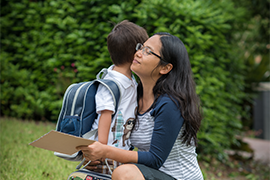 For many families with older children between the ages of 9 and 12, the time comes when you must decide if your child is ready to care for himself. While some parents leave for work before school opens, others finish work long after school is over. Often there are few sitters or after-school programs available at these times.
For many families with older children between the ages of 9 and 12, the time comes when you must decide if your child is ready to care for himself. While some parents leave for work before school opens, others finish work long after school is over. Often there are few sitters or after-school programs available at these times.
Some families may learn suddenly the babysitter is no longer available or that their child is unhappy with his child care arrangements. Some children ask to try new activities and stay home alone. Sometimes care is too expensive or certain child care arrangements are not available during school breaks. The transition to having your child stay home alone is a big step for every family.
Is Your Child Ready?
Consider your child's maturity level and his ability to handle a variety of situations. If you answer "yes" to most of the following questions, this may indicate your child is ready to stay alone.
- Has he handled brief periods of being left alone well?
- Will he come straight home after school?
- Will he be lonely or frightened by himself?
- Can he manage simple jobs like fixing a snack and taking phone messages?
- Is he physically able to unlock and lock the doors at home?
- Can he solve small problems himself?
- Does he know when and how to seek outside help?
- Is he prepared to handle an accident or an emergency?
- Will he follow the rules set for him and use his time productively?
Self Care Options
As you begin to explore the idea of self care for your child, consider all options. For some families a combination of arrangements may be the best plan. You might enroll your child a couple of days in a local recreation or after-school program. Many libraries, churches and community centers also offer various activities, classes and school vacation programs for children.
Sometimes exchanging care with another parent works well. You might be able to offer before school care to someone who can supervise your child in the afternoon. Or, you might be able to arrange for evening care in exchange for care after school.
As your child spends time alone at home, you may want to schedule an activity at least one day a week. For some children an afternoon of sports, a music lesson, club meeting or visit to a friend's house is wonderful to look forward to and breaks the routine of being alone.
When to Begin
There is no specific age when children are ready to stay home alone because children mature at different rates. It is most important to know if your child feels comfortable being home alone and has the levelheadedness to handle an emergency. Consider too the amount of support you can count on from neighbors, family and friends.
Some states have laws regulating the age at which a child may be left home alone. You can find out what the law is where you live by calling the agency that oversees services for children and families.
The best way to begin is to have a conversation with your child. Listen to her feelings and concerns. If your child is anxious, you will want to proceed carefully with your arrangements. Starting self care may not be a good idea during a period of increased stress such as a move to a new home, a divorce or death in the family.
Build up hours gradually by leaving your child briefly to run an errand or arranging to arrive home fifteen minutes later than usual from work. Ask your child if she felt comfortable and what she did with her time. Encourage her to tell you of any fears she may have no matter how trivial. With practice you will both be ready for her to spend longer periods of time alone and you can plan a regular schedule of self care.
Establishing House Rules and Routines
There are many important steps you can take to ease your worries and help protect your child while you're not around. Sit down with her and go over the rules of your home including what to do if a stranger comes to the door or if friends want to come over. Decide together what kinds of snacks are allowed and how much, what things are "off limits" until a parent is home, and how the time alone will be spent.
Some working parents ask their child to check in by telephone. This is both a safety precaution and a way to hear a bit about your child's day. Arrange a backup person at work when you can't take the call. You and your child should agree on specific times when she can and cannot talk with friends on the phone.
For many families some kind of central check-in center at home is helpful. This can be a bulletin board or message area with magnets on the refrigerator door. You can post reminders for the day as well as important phone numbers.
Chores and projects can be a part of your child's afternoon routine. You should decide on specific times for chores, homework and free time. Keep a weekly schedule and checklist for your child to use. This routine will help your child feel secure and responsible.
Putting It All Together
Making decisions for the care of your older child is a challenge for all parents. Take time to consider various ideas and options and resist making quick decisions. Every child is a unique individual and what works for one child may not necessarily work for yours.
Continually evaluate your arrangements and be flexible. Consider new ideas and change your choices if your plan doesn't work. Add or change rules if necessary. Your workable plan may breakdown along the way as activities and sports start and finish, a dance lesson is unexpectedly canceled or there is a weather emergency.
Talk often with your child and listen to her likes and dislikes, fears and frustrations, joys and triumphs. This is a time of increased responsibility and independence for her. Together you can build on her ability and confidence to care for herself.
Safety Tips
Prepare your child to be ready for emergency situations. Go over the following together:
- his full name, address and phone number
- your full name and the address and phone number at your job
- the name and phone number of your designated back-up person
- the phone number for emergency services
- not to enter your home if a door or window is open or broken
- what to do if someone knocks on the door
- the location of a flashlight in good working order if the power should fail
- how to exit your home quickly in case of a fire
- the safety rules and routines of your home
- basic first aid procedures and the contents of your First Aid kit
Resources
- One starting point in planning school age resources is to call the main office of your school district and your nearest child care resource and referral agency. Some communities will also offer park and recreation programs, youth organizations such as Boys and Girls Clubs and YMCAs.
- The American Red Cross offers a Basic Aid Training course for children ages 8 to 10. Children learn safety information, first aid procedures, and skills to respond to em Contact the American Red Cross office nearest to you for more information.
- National Institute on Out of School Time at Wellesley College in Massachusetts is a national organization providing information and assistance, programs and conferences, newsletters and materials. Visit www.niost.org.
The Daily Parent is prepared by NACCRRA, the National Association of Child Care Resource and Referral Agencies.
© 2012 NACCRRA. All rights reserved.





